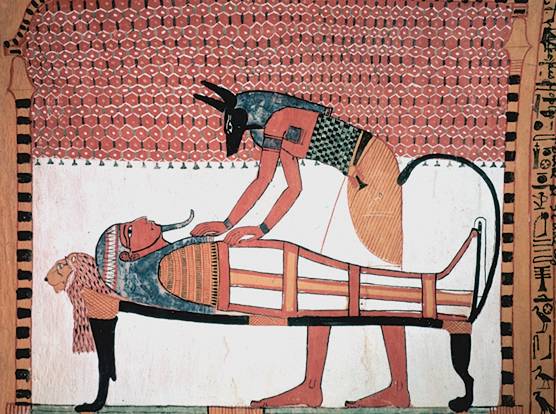Gigi Taymour
London, England

Through the stability of ancient Egyptian society, governmental system, and organized economy, medical knowledge advanced rapidly.1 The Egyptians successfully integrated complex healthcare practices with religion, botanical cures, and surgical procedures. Although some scholars have argued that religious beliefs may have hindered the development of medicine, the documented literature such as the Ebers Papyrus and the Edwin Smith Papyrus shows that religion played an important role in furthering knowledge.
The ancient Egyptians believed that all illnesses were primarily caused by gods, spirits, and demons. They agreed that these spirits created within the body “blocked channels” that restricted bodily functions.2 As a result, they recommended a combination of prayers and non-spiritual remedies. Most healers in the Middle Kingdom were priests, but different levels of expertise began to emerge. The priests prayed to Imhotep, a healing deity, for good health.3 The magicians had similar beliefs. They would often ward off evil spirits to restore health, as observed in The Book of the Dead, an ancient Egyptian funeral manuscript used from the start of the New Kingdom until about 50 BC. It served to protect and aid the deceased by means of spells or magic formulas. There were also the Swnw (sinew) who relied on natural medications and minor surgical procedures, like modern-day physicians. All these remedies have been recovered in several papyri, notably the Edwin Smith Papyrus and the Ebers Papyrus.
The Ebers Papyrus remains to this day one of the most influential documents in medical literature. Written around 1500 BC, it is thought to contain copies of material from 3400 BC.4 It covers topics on the cardiovascular system and minimally invasive surgeries. Although it keeps to its roots and delves into religious aspects and beliefs about physical and mental illness, it focuses on natural medications and remedies.
The ancient Egyptians held the heart in high regard, both physically and spiritually. According to the Ebers Papyrus, the heart was the center of the body’s blood supply, and extending from the heart was an abundance of vessels that “connected to every corner of the body.”5 The Ebers Papyrus also considered “knowing the movements of the heart” as “the beginning of the secrets of the physician.”6 Although physical descriptions of the heart vary substantially from modern-day descriptions, researchers in 2014 dubbed ancient Egyptian understanding as “surprisingly sophisticated, if not accurate.”7
The ancient Egyptians’ fascination with the functions of the cardiovascular system allowed them to make important breakthroughs and gain a deeper understanding of anatomy, reflecting the assistance religion played in advancing the practice of medicine.
The Edwin Smith Papyrus, the oldest known surgical text, was discovered in 1862 at Luxor.8 It is split up into different cases, most of which explain injuries. Case by case, it briefs the physician on physical symptoms which would allow a diagnosis and possible treatment.9 Although the use of physical examination and reasoning is something we take for granted in modern medicine, this was unusual 5,000 years ago. Today, much wisdom held by physicians stems from the Edwin Smith Papyrus. Its authors uncovered foundational concepts of medicine using sophisticated reasoning and logic.
Ancient Egyptians made little distinction between magic and medicine. Both used similar methods, and there was much overlap between their processes and treatments. The religious aspects of culture also helped medicine to advance. Today, it is possible to see much of the origins of medical practices through sources such as The Book of the Dead, the Ebers Papyrus, and the Edwin Smith Papyrus.
References
- Dan Moorehouse, “Religion and Medicine in Ancient Egypt,” School History, accessed July 19, 2023, https://schoolshistory.org.uk/topics/medicine-through-time/ancient-egyptian-medicine/religion-and-medicine-in-ancient-eygpt/.
- Yvette Brazier, “What Was Ancient Egyptian Medicine Like?” ed. Daniel Murrell, Medical News Today, last modified November 18, 2018, accessed July 21 2023, www.medicalnewstoday.com/articles/323633.
- Brazier, “What Was Ancient Egyptian Medicine Like?”
- Justin Barr, “Vascular Medicine and Surgery in Ancient Egypt”, page 261, Journal of Vascular Surgery vol. 60, no. 1 (2014): 260-3, www.sciencedirect.com/science/article/pii/S0741521414008659.
- Cyril Bryan, “Ancient Egyptian Medicine: The Papyrus Ebers,” page 145, History of Medicine, HathiTrust, [babel.hathitrust.org/cgi/pt?id=coo.31924073200077&seq=1].
- Barr, “Vascular Medicine.”
- Brazier, “What Was Ancient Egyptian Medicine Like?”
- Marc Stiefel et al, “The Edwin Smith Papyrus: the birth of analytical thinking in medicine and otolaryngology,” abstract, Laryngoscope vol. 116, no. 2 (2006): 164, pubmed.ncbi.nlm.nih.gov/16467701/.
- Joost Van Middendorp et al, “The Edwin Smith papyrus: a clinical reappraisal of the oldest known document on spinal injuries.” European Spine Journal, vol. 19, no. 11 (2010): 298, www.ncbi.nlm.nih.gov/pmc/articles/PMC2989268/.
GIGI TAYMOUR is a high school senior at the American School in London. Along with taking part in multiple extracurricular activities, Gigi has a passion for science, and is hoping to pursue Public Health in university. The author would like to thank Dr. Assad Bakir and Dr. Sally Metzler for mentoring her in the composition of this article.

Leave a Reply